How to spend two days in Berlin with kids?
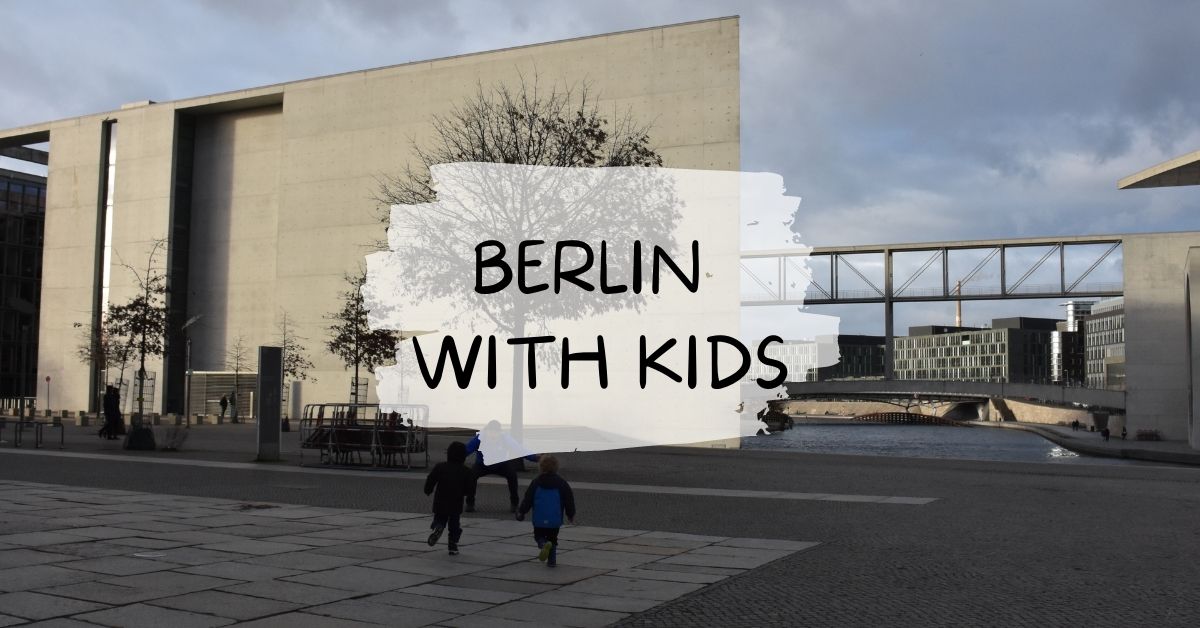
After two long winters of our discontent, things seem to be easing up COVID-wise in Germany. Never having visited the capital of the country we currently live in, it appeared that the time had finally arrived to visit Berlin. I found a reasonably priced train ticket and hotel, so our family of four set out on a new adventure. The day before our departure, fierce storms ravaged all of Germany, and the media warned everyone about a threatening hurricane and subsequent train delays. We nevertheless didn’t cancel our trip and spent a fun and educative weekend in Berlin with our children. So what to do in Berlin on rainy days with kids? How to spend two days in the German capital? How to squeeze in contemplating historical events for adults and boisterous roughhousing for kids in 48 hours?
Preparations for two days in Berlin
I have to admit that even if we have traveled to over 20 countries with very young kids, it still takes a day of preparation to leave for 2 to 7 days.
COVID-documentation
At the time of writing (February 2022), 2G+ rules apply for tourism. If you have three vaccinations, you can travel by public transportation, visit attractions and go to restaurants and hotels. If you have two vaccinations and a negative test, you are also good to go.
Packing for two children (aged 3 and 5)
We usually pack light and travel with four carry-on backpacks.
The childrens’ backpacks are tiny, but they learned to pack every toy they might need. Besides the most crucial cars, I usually packed some coloring pages, crayons, reading books and card games into their backpacks. I prefer to pack older toys to “forget” them at the hotel. Most hotels have a kid’s corner or a bookcase so other kids can enjoy our old toys. It is also a great way to lighten the load and make room for souvenirs.
Our backpacks for two rainy days in Berlin
- passports, credit cards, COVID documentation, tickets (yes, we are from an older generation, we like to print them)
- medications
- diapers
- rain pants (Matschhose: German kids always wear them)
- umbrellas
- two sets of clothes for everyone and an extra set for the children
- PJs, toiletries: toothpaste, toothbrushes, deodorant, moisturizer, tweezers
- Swiss army knife
- food for the train
- cameras, phones, books, chargers
And that is all, as there is no room for anything else in four small backpacks. The essential things are credit cards, paperwork and my son’s EpiPen. You can buy everything else in a place like Berlin.
Getting to Berlin
We traveled by train after finding a Super Saver ticket on the homepage of Deutsche Bahn. If you start looking early and are willing to travel outside the high season, you will find irresistible deals.
We had to take to regional and an InterCity train to Berlin. Most trains were canceled or delayed because of the weather. They canceled our trains, too, and zero information was provided online or on the platforms about the delays. So we just went to the Bahnhof in our town, took the first train that went in the right direction, repeated the same thing three more times, and arrived in Berlin some half an hour later than planned. Of course, they were all different trains and routes than our ticket, but nobody said a word about being on the wrong train. After all, it was during a hurricane warning.
Otherwise, if you travel in Germany under normal circumstances (no once-in-a-century-storm), expect some delay on regional trains (there is an R or RE in their number), but the IC, ICE trains are punctual.
Sightseeing in Berlin in 2 (and a half) days
Sightseeing with children can be exhausting if you expect them to walk a lot or appreciate art galleries. They WILL whine, and the experience will be miserable for the whole family.
How to have family fun during a day of sightseeing?
- If your kids still nap during the day, make sure they get some rest (on the train, in the car, back in the hotel.)
- Bring snacks.
- Let them carry one or two small toys.
- Prepare extra clothes, wipes, diapers.
- Alternate between kids and grown-up programs: we play in this playground now, and after that, Mum and Dad would like to visit this museum.
- Don’t spend too much time in museums. Accept that you have the chance to scratch the surface, not to immerse yourself in culture.
- If your kid whines before entering a gallery, don’t go in. No artwork is worth a screaming kid in a museum.
- Let them choose a place to eat.
On the day of our arrival
After checking into our hotel, it was mid-afternoon, so we had time to visit two attractions.
Naturkundemuseum
The Natural History Museum is a kilometer (or one bus stop) away from the Central Station (Hauptbahnhof).
A 12-meter tall Brachiosaurus skeleton is the main attraction of the museum. Its sheer size is awe-inspiring, but the other dino-skeletons (Archaeopteryx) and bones are also worth your time and money. The museum boasts a prime collection of minerals if that is your thing. The exhibition of the marvels of taxidermy is interesting for kids, albeit a little creepy for my taste.
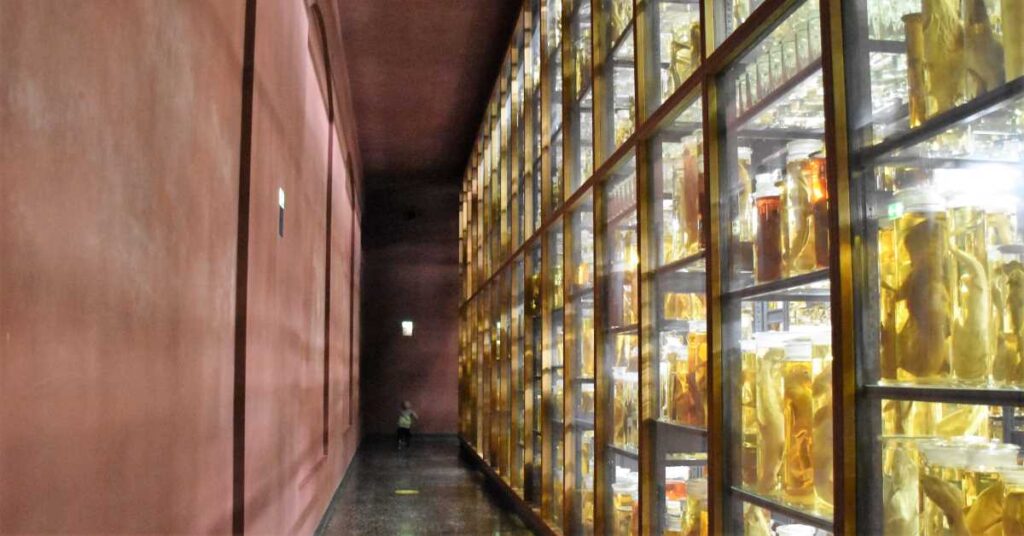
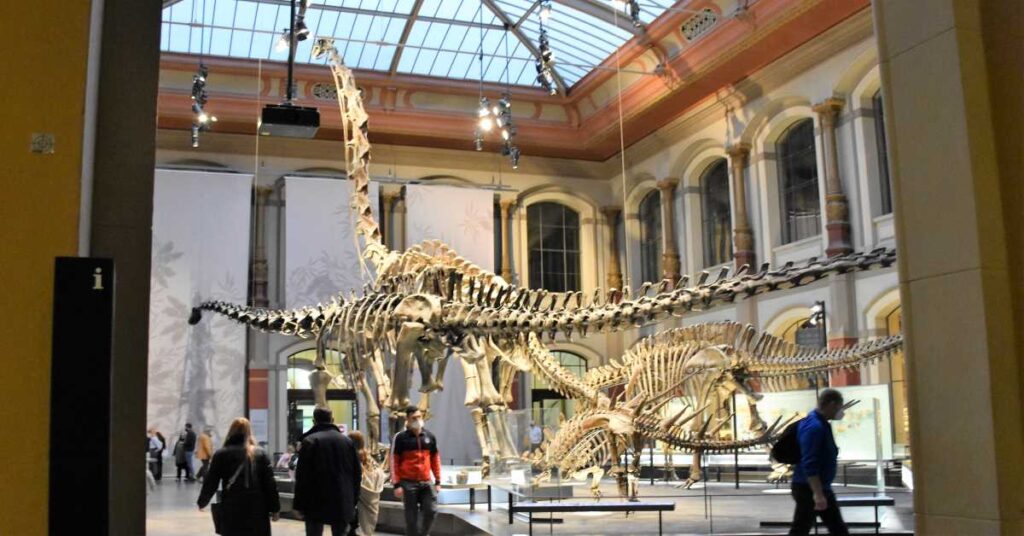
Gedenkstätte Berliner Mauer
The Berlin Wall Memorial on the Bernauer Strasse is a ten-minute walk from the Naturkundemuseum.
The 1.4 kilometer-long strip is the only section of the Berlin Wall to be fully preserved. The construction of the Wall in 1961 put a violent end to everyday life on Bernauer Strasse. Overnight, neighbors and relatives were separated.
The Berlin Wall Memorial extends on both sides of Bernauer Strasse. On the border strip, initially located in East Berlin, the outdoor exhibition on the division can be seen. The visitor center is on the opposite side of the street. It originally belonged to the western part of the city.
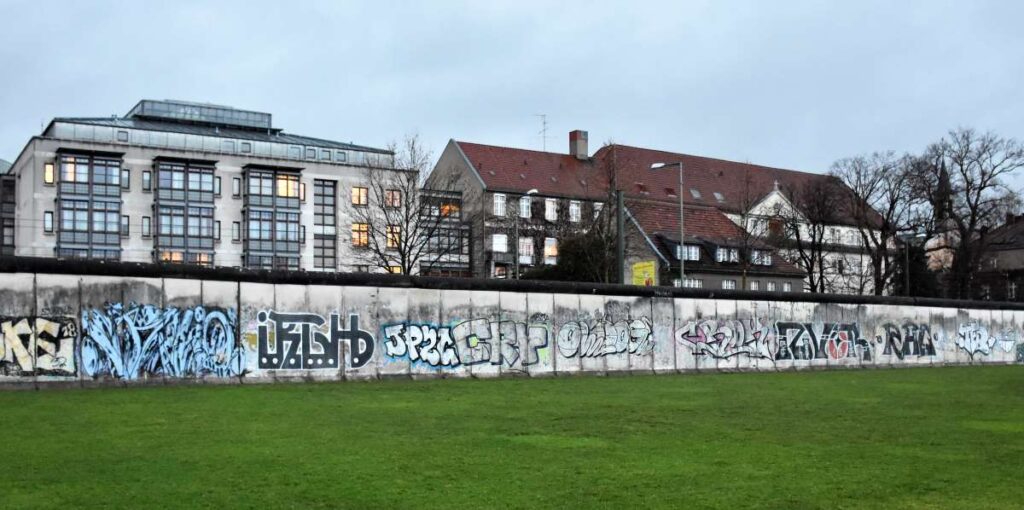
Dinner
After the long journey and walk in the awful weather, we warmed up our fingers and soul with a well-deserved vegan lemongrass and tofu orgy in this lovely Vietnamese restaurant.
Day 1: Berlin Mitte
Checkpoint Charlie
In 1961, the Berlin Wall was built. From then on, crossing from West to East Berlin was only possible through checkpoints.
The best-known border crossing was Checkpoint Charlie on Friedrichstrasse, in the city center. Diplomats, military, and allies entered another world through e checkpoint. Crossing from the East to the West was not allowed.
Who is Charlie? The name doesn’t refer to a person, it’s simply the 3rd letter of the NATO alphabet. There used to be Checkpoint Alpha and Bravo, too.
My American husband traveled around Europe in the early ’80s and visited East Berlin through Checkpoint Charlie. According to his narrative, he had to change and spend a certain amount of East German Mark. As the shelves in the stores were mainly empty, he couldn’t spend it on anything else but stale bread containing a significant amount of sawdust and comic books about Lenin. (No, seriously.)
My Hungarian dad, who hitch-hiked all across the Eastern block in the ’70s, didn’t even dare to approach the Wall in East Berlin. He remembers looking at the Checkpoint from a safe distance. When I showed him pictures of the remains of the Berlin Wall, today in 2022, he was surprised at how thin it was. He said he had always imagined it a lot thicker.
Today, there is a Museum next to Checkpoint Charlie. The Mauermuseum is filled with incredible stories about the people of East Berlin who used their ingenuity and creativity to escape to West Berlin.
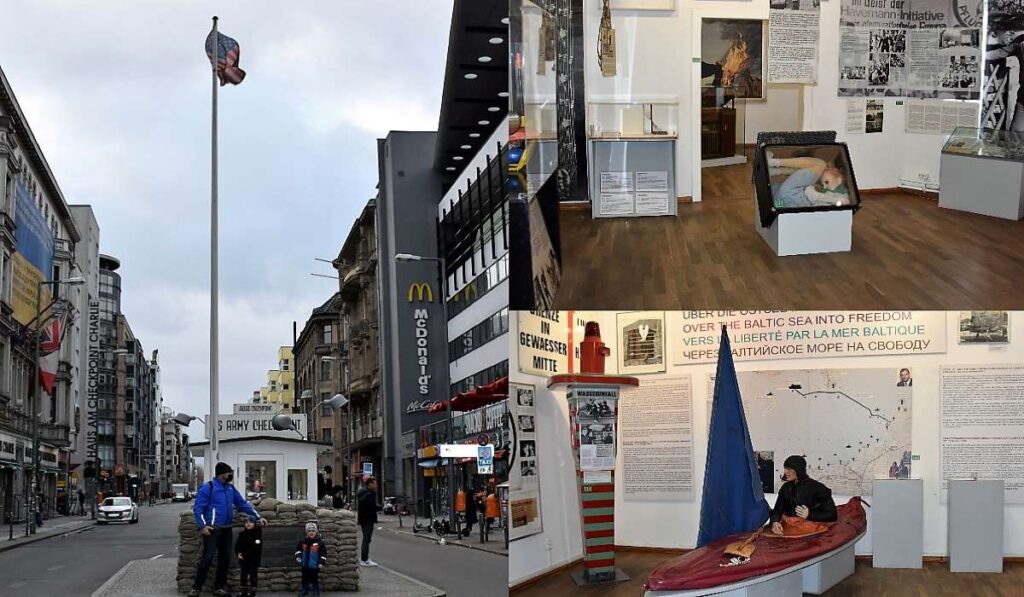
Trabi Museum
Finally, something interesting for the kids after the history lesson about the Berlin wall.
Oh, the Trabant! The unobtainable object of our desires in the Eastern block! The peculiar shandandandandandaran sound of its two-stroke engine! The thermosetting plastic chassis!
The Trabant has excellent road-holding and impeccable acceleration. However, this should not tempt one into unwariness.
These memorable sentences of the Trabant user manual were made eternal by Péter Esterházy in his novel Little Hungarian Pornography.
In the Trabi Museum, you can see well-maintained specimens of this iconic vehicle.
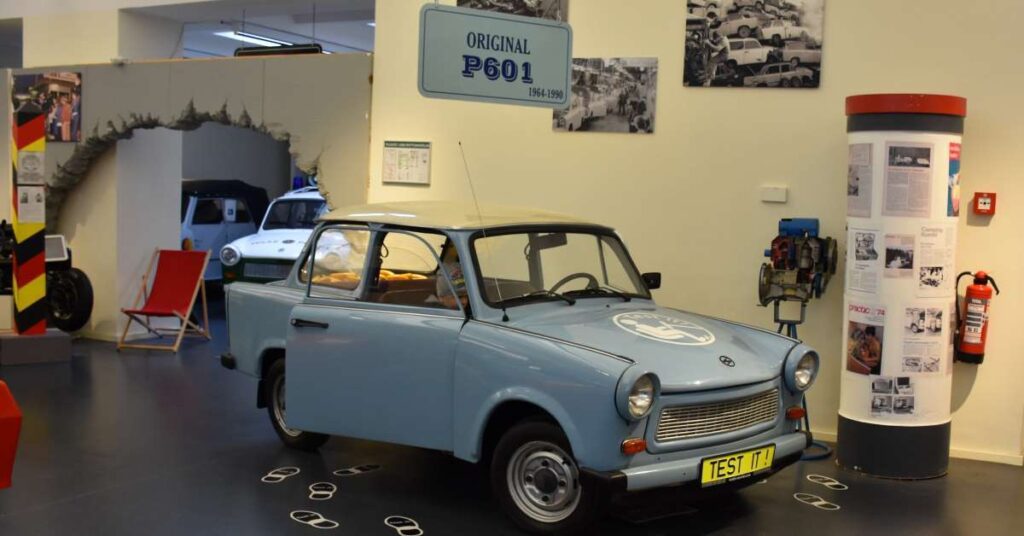
Topography of Terror
One of the most frequently visited memorial sites in Berlin, the “Topography of Terror” is an exhibition on the site where the principal instruments of Nazi terror were located. At the former headquarters of the Gestapo, the SS, and the Reich, photographs and documents illustrate the history of the Third Reich.
As such, it is not the place to bring young children.

Holocaust Memorial
The Memorial to the Murdered Jews of Europe is one of the most impressive sights in Berlin.
It consists of an undulating field of 2711 concrete slabs (or stelae) of different heights. While walking between the maze of columns, visitors may get lost. The feeling of disorientation and the sheer number of massive grey concrete blocks resembling coffins and representing the unimaginable number of unnamed victims of the Holocaust evoke contemplation. Our family lost each other in the Memorial, as it is common for groups of visitors as they wander deeper into the structure. This often reminds one of the separation and loss of Jewish families during the Holocaust.
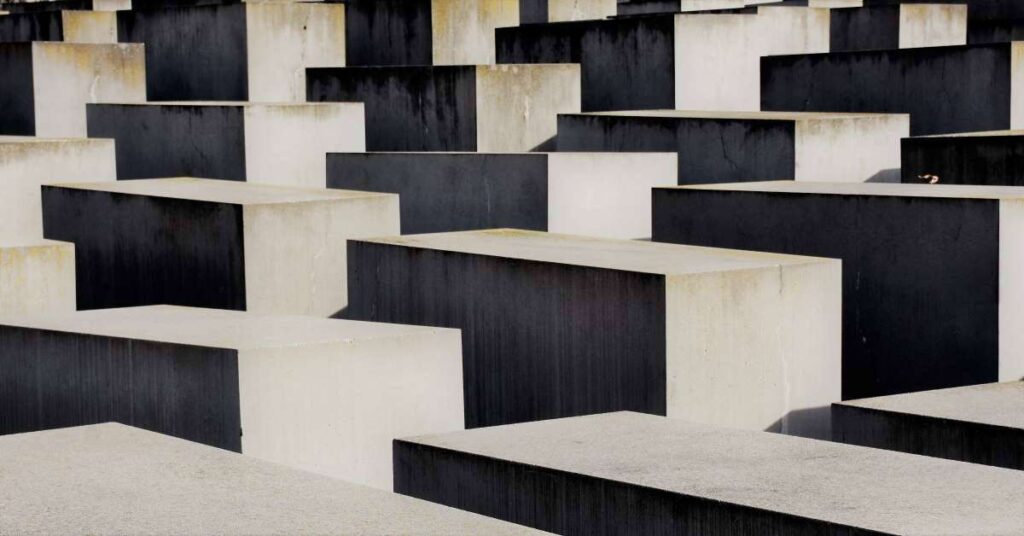
Tiergarten
Opposite the Holocaust Memorial (and Brandenburg Gate) the popular green area of downtown Berlin is the perfect stopover for families with kids during sightseeing. Here, our kids could run around, as we took turns in exploring the Holocaust Memorial on the other side of the road.
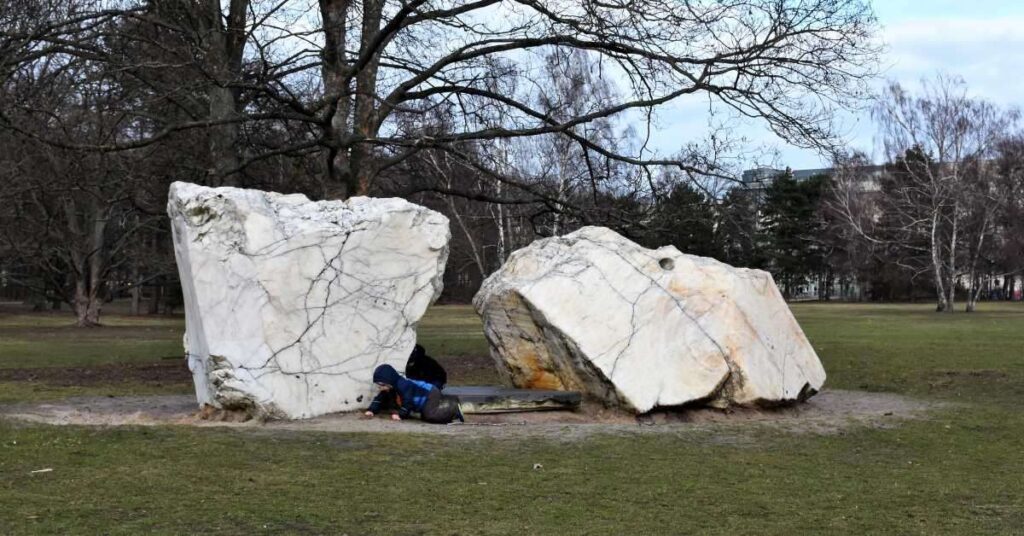
Brandenburg Gate
Towards the end of our sightseeing tour, we followed the examples of monarchs, Napoleon and Helmut Kohl: we walked across one of the best-known landmarks of Germany, the Brandenburg Gate.
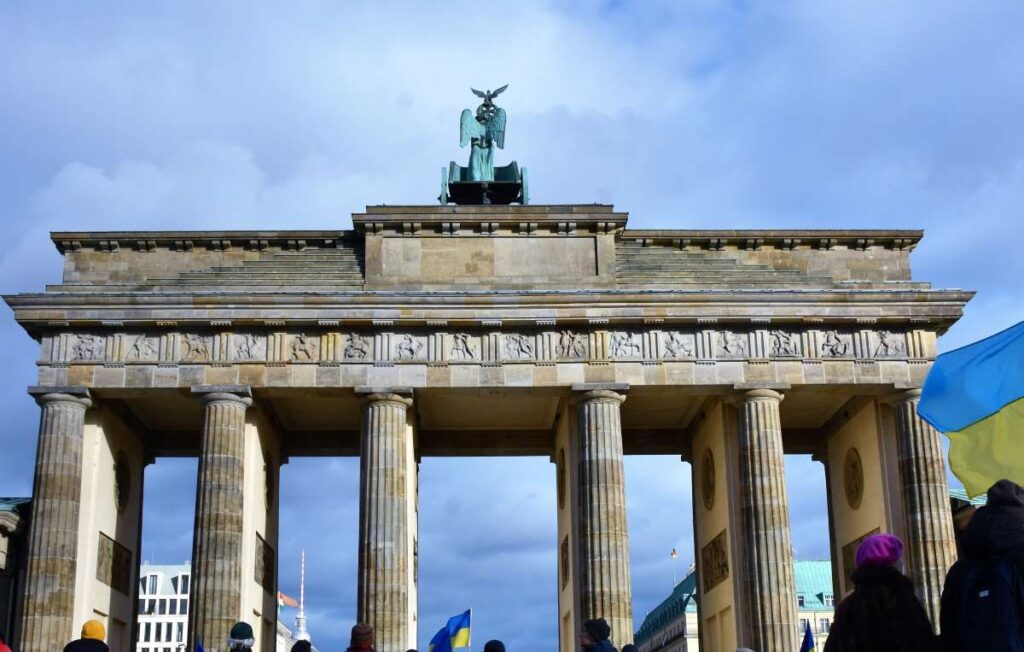
Pro-Ukraine demonstration at the Brandenburg Gate
Reichstag
After being burnt, bombed, and rebuilt, the Reichstag building has been the seat of the German parliament – the Bundestag – since 1990.
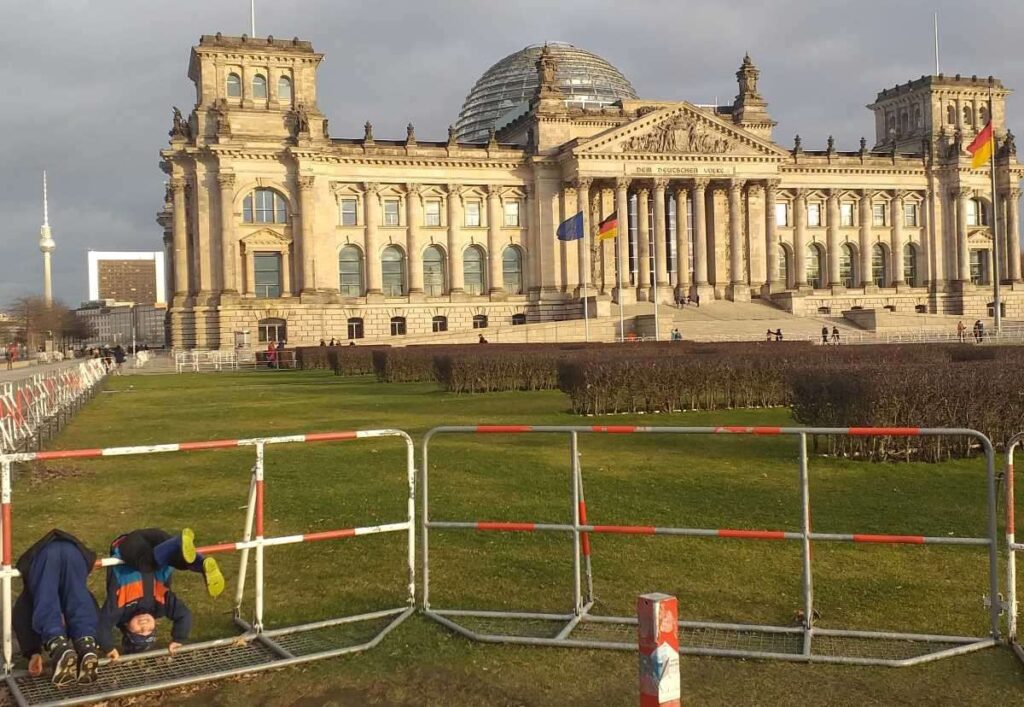
Day 2: Around Museuminsel
Gendarmenmarkt
Considered the most beautiful square in Berlin, the Gendarmenmarkt has been at the top of every tourist’s sightseeing list for a long time. The site of an architectural ensemble includes the Berlin Concert Hall and two churches that look almost identical at the first sight: the French and German churches.
Bebelplatz
When you stroll across Bebelplatz, you often come across people staring at the same spot on the ground. When you get closer, you see an underground room with empty bookshelves. The sunken library shows what is missing. The underground bookshelves have space for around 20,000 books, as a reminder of the 20,000 books that went up in flames here on 10 May 1933 at the behest of the Nazis.
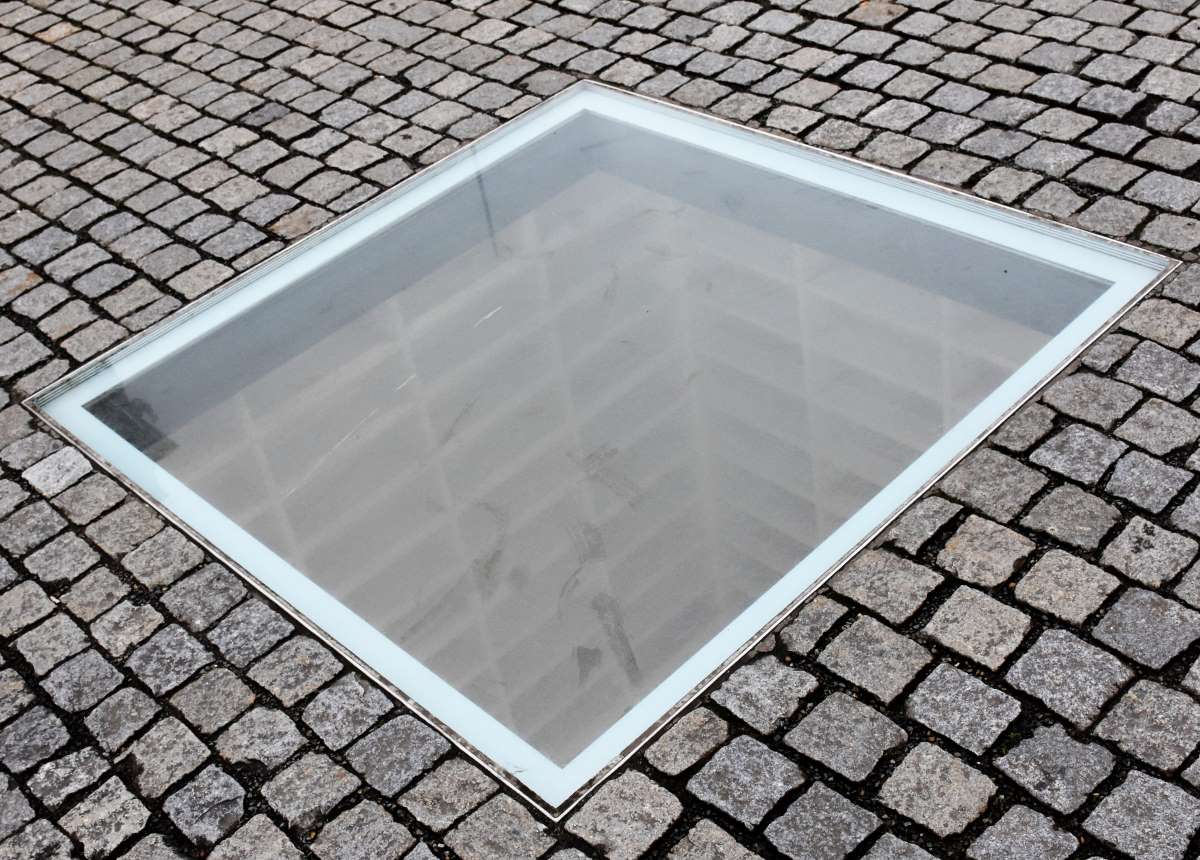
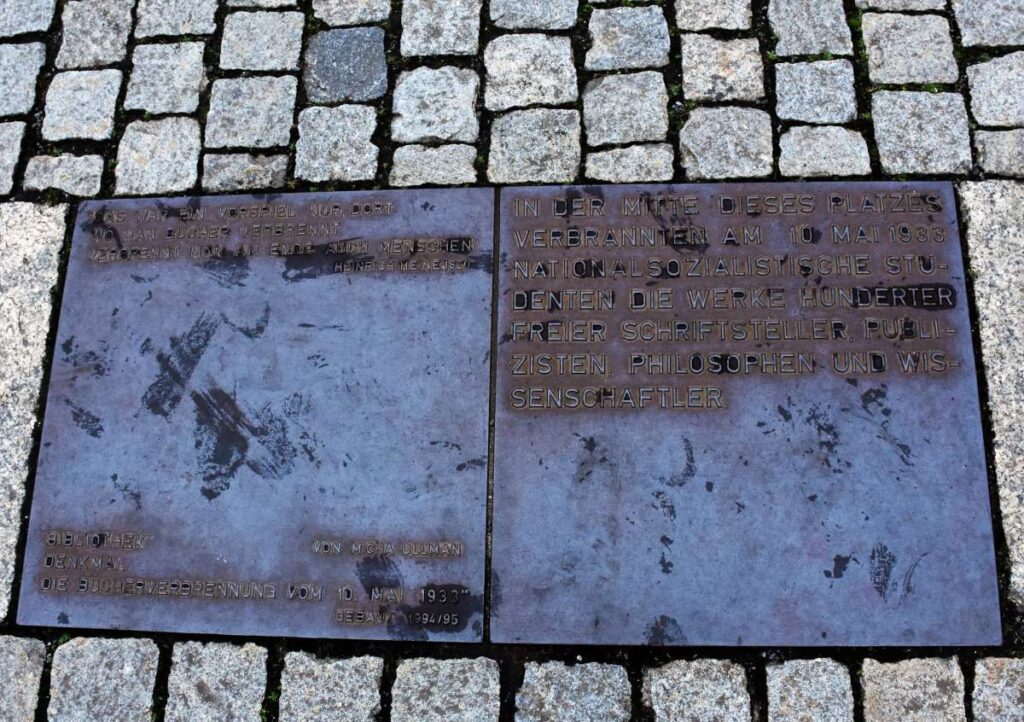
Museuminsel
The Museum Island is a museum complex on the island of the Spree river. It is one of the most important museum sites in Europe. The UNESCO World Heritage Site consists of the Altes Museum, the Neues Museum, the Pergamonmuseum, the Alte Nationalgalerie, the Bode-Museum. The Berliner Dom is also located here, near the Lustgarten.
Now, none of these is an ideal place to visit with young children, so our family split up into two. My husband took the kids, and I had my me-time frolicking around in the Museuminsel. I have always been fascinated by the Ishtar Gate, ever since it was on the cover of my 7th-grade history textbook. Luckily, it is exhibited in the Pergamonmuseum. Unluckily, the tickets were sold out by the time I got there. There is a lesson here: before visiting, be more prepared than I was and book tickets online in advance.
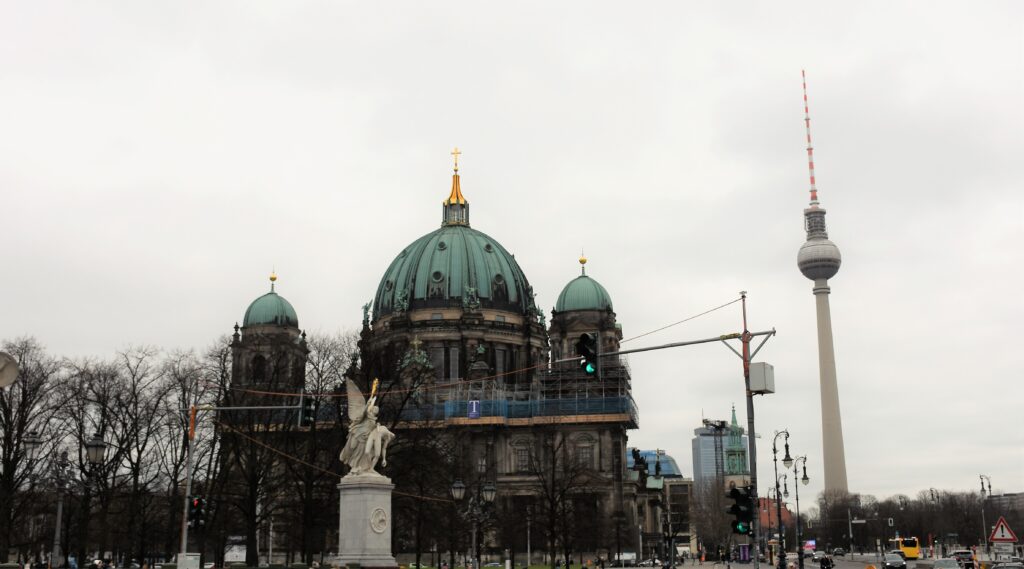
Altes Museum
The only place I could buy a ticket for on the spot was the Old Museum. The Neoclassical building houses an extensive antiquities collection. The Etruscan, Roman and Classical Greek sections abound in masterpieces that I have previously only seen on filmstrip during my art history studies
Magic Museum
While I was admiring the fragile masterpieces, my husband with our two sons visited a more kid-friendly location not so far from Museum Island. The Magic Museum is an interactive exhibition about the history of the occult, alchemy, witchcraft, religion and magic. The displays are clever and you learn a bit. Bring a sense of fun. It is best for kids who like puzzles and games. They said it was a great program for a rainy day.
DDR Museum
Near Museuminsel, on the bank of river Spree, you will find an immersive experience of everyday life in former East Germany. Covering a range of topics – everyday life, the Berlin Wall, the Stasi – the exhibition encourages its visitors to interact, to gain a fun understanding of the past. My kids enjoyed the Trabi simulator, the typical toys from the DDR era, and that they are not only allowed but encouraged to touch EVERYTHING. I myself swallowed the sweet tears of nostalgia when I discovered that the exhibits include the same bathtub, kitchen cupboard and stereo player we used to have back in those days.
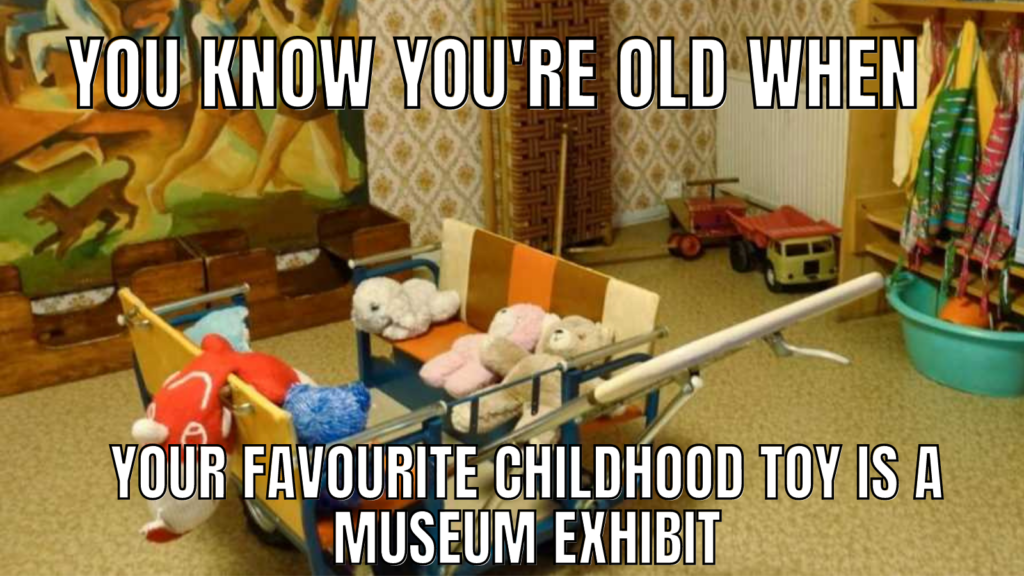
Here’s how our 2-day trip to Berlin looks on the map
On the day of our arrival we took a bus to the Naturkundemuseum, and walked back towards the Central Station. The first day, we took the U-Bahn to Checkpoint Charlie, and walked back. The second day, we took the S-Bahn towards the Museuminsel and back.





Ahhh I remember traveling with little kids and making plans for all of the cool museums that my girls would love. I loved that time of life. I love that we can plan more adult adventures now too.
These are such great ideas for a trip to Berlin with the family! I will be pinning this for later. All of the museums sound so interesting!
Berlin looks so cool! I would so love to visit one day. Also, really appreciate the recommendation for the place that serves vegan Vietnamese pho!
This is idiotic thinking you’re so old as your fave toy is in a museum.
They do have toy museums which feature toys from every decade.